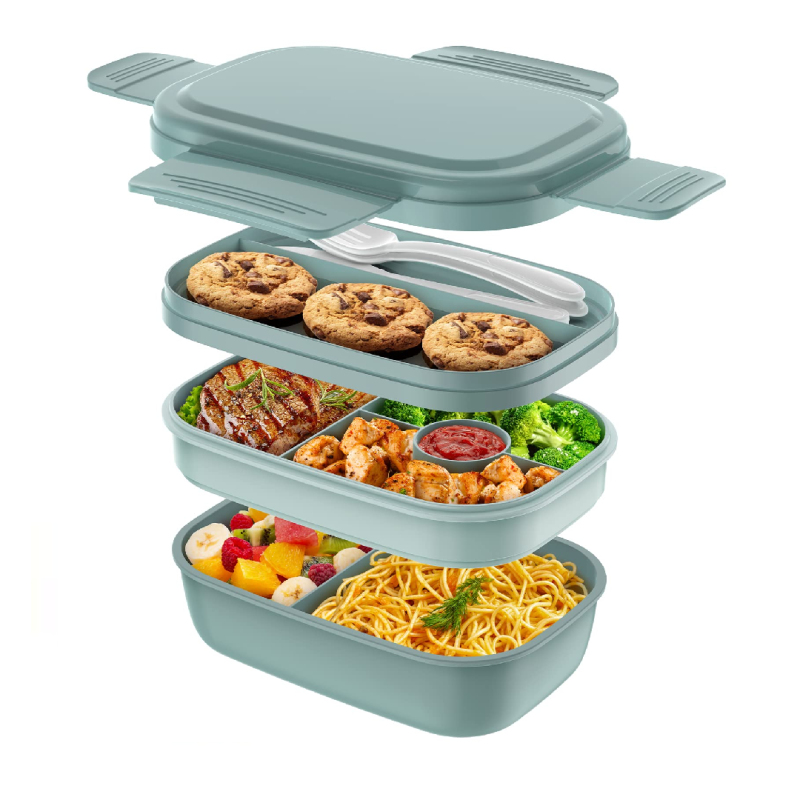
Item Code:
91567264868dBrand:
Bento boxes are traditional Japanese meal containers that have gained worldwide popularity for their practical design and aesthetic appeal. Originating in Japan centuries ago, bento boxes feature multiple compartments that allow for organized presentation of different food items. These containers typically separate rice, proteins, vegetables, and other components to prevent flavors from mixing while creating an appealing visual arrangement. The Japanese approach to bento emphasizes balance in nutrition, color, and texture, making meals not only delicious but also visually pleasing.
Traditional bento boxes were made from wood or lacquerware, but modern versions utilize various materials including plastic, stainless steel, and glass. The compartmentalized design serves both practical and cultural purposes - it helps with portion control and reflects the Japanese culinary principle of presenting food in an artful manner. Many bento enthusiasts enjoy the creative aspect of arranging meals, sometimes creating elaborate designs known as "kyaraben" (character bento) that resemble popular cartoon characters or animals.
Contemporary lunchboxes have evolved significantly from the simple metal boxes of the past. Today's market offers an extensive range of options catering to different needs and preferences. Insulated lunch bags keep food at safe temperatures for hours, while bento-style containers with multiple compartments help maintain food separation. Many modern lunchboxes feature leak-proof designs, microwave-safe materials, and eco-friendly construction using sustainable materials like bamboo fiber or stainless steel.
Popular lunchbox categories include compartmentalized bento boxes for varied meals, insulated containers for hot foods, salad containers with separate dressing compartments, and stackable systems for families. The growing emphasis on sustainability has led to increased demand for reusable lunchboxes that reduce single-use plastic waste. Many manufacturers now produce BPA-free, dishwasher-safe options that combine convenience with environmental responsibility. The right lunchbox can make meal preparation more efficient and enjoyable while encouraging healthier eating habits through proper portioning.
Using dedicated lunch containers offers numerous advantages beyond simple food transportation. The compartmentalized design of bento boxes naturally encourages balanced meals with appropriate portions of different food groups. This structure helps prevent overeating while ensuring nutritional variety. For parents, bento boxes simplify packing school lunches that include fruits, vegetables, proteins, and carbohydrates in visually appealing arrangements that children find more enticing.
From an economic perspective, regularly using lunchboxes significantly reduces costs compared to purchasing meals daily. Bringing homemade food also provides better control over ingredients, accommodating dietary restrictions and preferences more easily than restaurant options. Environmentally conscious consumers appreciate that reusable lunch containers dramatically decrease waste from disposable packaging. The ritual of preparing and packing meals can become a mindful practice that fosters healthier relationships with food and eating habits.
Selecting an appropriate lunchbox depends on several factors including intended use, personal lifestyle, and specific needs. For school children, durability, ease of opening, and compartmentalization are key considerations. Adults might prioritize professional appearance, insulation capabilities, or eco-friendly materials. Active individuals often seek leak-proof designs that can withstand movement in bags or backpacks without spilling contents.
Material choice significantly impacts functionality and safety. Stainless steel options offer durability and are generally free from harmful chemicals but may not be microwave-safe. Glass containers provide excellent food safety and microwave compatibility but can be heavier and more fragile. High-quality plastics balance lightweight convenience with durability but require verification of BPA-free status. The size and number of compartments should align with typical meal contents - those who enjoy salads with separate dressings benefit from specialized containers, while others might prefer adjustable dividers for flexibility.
Additional features to consider include airtight seals for liquid-containing foods, dishwasher safety for easy cleaning, and compatibility with freezing for meal prepping. Some modern lunchboxes incorporate smart features like temperature indicators or built-in utensils. Ultimately, the ideal lunchbox combines practical functionality with personal aesthetic preferences, making the daily ritual of meal preparation and consumption more enjoyable and sustainable.
Lunchboxes and bento boxes represent more than simple food containers - they are tools that promote healthier eating habits, environmental responsibility, and mindful meal preparation. Whether opting for traditional Japanese bento designs or modern insulated versions, these containers help transform daily meals into organized, balanced, and enjoyable experiences. The wide variety of available options ensures that everyone can find a lunch solution that fits their specific needs while contributing to reduced waste and improved nutrition.